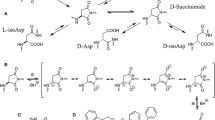Abstract
Deamidation of Asn residues can occur either by direct hydrolysis of the Asn residue or via a cyclic imide intermediate. The effects of primary sequence on the pathways of deamidation of Asn residues were studied using Val-Tyr-X-Asn-Y-Ala hexapeptides with substitution on the C-terminal side (Y) and on the N-terminal side (X) of the Asn residue. In acidic media the peptides deamidate by direct hydrolysis of the Asn residue to yield only Asp peptides, whereas under neutral or alkaline conditions, the peptides deamidate by formation of the cyclic imide intermediates which hydrolyze to yield both isoAsp and Asp peptides. At neutral to alkaline pH's the rate of deamidation was significantly affected by the size of the amino acid on the C-terminal side of the Asn residue. The amino acid on the C-terminal side of the Asn residue has no effect on the rate of deamidation at acidic pH. Changes in the structure of the amino acid on the N-terminal side of the Asn residue had no significant effect on the rate of deamidation at all the pH's studied. For peptides that underwent deamidation slowly, a reaction involving the attack of the Asn side chain on the peptide carbonyl carbon resulting in peptide bond cleavage was also observed.
Similar content being viewed by others
REFERENCES
M. C. Manning, K. Patel, and R. T. Borchardt. Pharm. Res. 6:903–918 (1989).
A. B. Robinson and C. J. Rudd. In B. L. Horecker and E. R. Stadtman (eds.), Current Topics in Cellular Regulations, Vol. 8, Academic Press, New York, 1974, pp. 247–295.
T. Geiger and S. Clarke. J. Biol. Chem. 262:785–794 (1987).
R. C. Stephenson and S. Clarke. J. Biol. Chem. 264:6164–6170 (1989).
S. Capasso, L. Mazzarella, F. Sica, and A. Zagari. Pept. Res. 2:195–200 (1989).
R. Lura and V. Schirch. Biochemistry 27:7671–7677 (1988).
Y. C. Meinwald, E. R. Stimson, and H. A. Scheraga. Int. J. Peptide Protein Res. 28:79–84 (1986).
M. Bodanszky and J. Z. Kwei. Int. J. Peptide Protein Res. 12:69–74 (1978).
I. Schon and L. Kisfaludy. Int. J. Peptide Protein Res. 14:485–494 (1979).
T. Baba, H. Sugiyama, and S. Seto. Chem. Pharm. Bull. 21:207–209 (1973).
S. A. Bernhard, A. Berger, J. H. Carter, E. Katchalski, M. Sela, and Y. Shelitiny. J. Am. Chem. Soc. 84:2421–2434 (1962).
K. Patel and R. T. Borchardt. Pharm. Res. 7:703–711 (1990).
J. Stewart and J. S. Young. In Solid Phase Peptide Synthesis, 2nd ed., Pierce, Rockford, IL, 1984, pp. 71–95.
G. Allen. In T. S. Work and R. H. Burdon (eds.), Sequencing of Proteins and Peptides, North-Holland, Amsterdam, 1981.
E. D. Murray, Jr., and S. Clarke. J. Biol. Chem. 259:10722–10732 (1984).
I. H. Segel. Biochemical Calculations, John Wiley and Sons, New York, 1968.
D. W. Aswad. Anal. Biochem. 137:405–409 (1984).
B. A. Johnson, E. D. Murray, Jr., S. Clarke, D. B. Glass, and D. W. Aswad. J. Biol. Chem. 262:5622–5629 (1987).
C. E. M. Voorter, W. A. de Haard-Hoekman, P. J. M. van den Oetelaar, H. Bloemendal, and W. W. de Jong. J. Biol. Chem. 263:19020–19023 (1988).
A. S. Inglis. Methods. Enzymol. 91:324–332 (1983).
T. J. Ahern and A. M. Klibanov. Science 228:1280–1284 (1985).
S. E. Zale and A. M. Klibanov. Biochemistry 25:5432–5444 (1986).
K. Patel, C. Oliyai, R. T. Borchardt, and M. C. Manning. J. Cell. Biochem. 13A:A318 (1989).
M. A. Ondetti, A. Deer, J. T. Sheehan, J. Pluscec, and O. Kocy. Biochemistry 7:4069–4075 (1968).
A. A. Kossiakoff. Science 240:191–194 (1988).
I. M. Ota, L. Ding, and S. Clarke. J. Biol. Chem. 262:8522–8531 (1987).
I. M. Ota and S. Clarke. Biochemistry 28:4020–4027 (1989).
Author information
Authors and Affiliations
Rights and permissions
About this article
Cite this article
Patel, K., Borchardt, R.T. Chemical Pathways of Peptide Degradation. III. Effect of Primary Sequence on the Pathways of Deamidation of Asparaginyl Residues in Hexapeptides. Pharm Res 7, 787–793 (1990). https://doi.org/10.1023/A:1015999012852
Issue Date:
DOI: https://doi.org/10.1023/A:1015999012852




